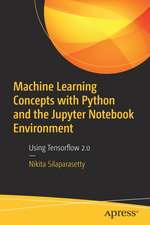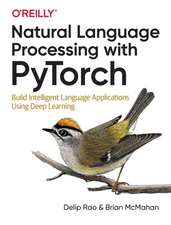Applied Neural Networks with TensorFlow 2: API Oriented Deep Learning with Python
Autor Orhan Gazi Yalçınen Limba Engleză Paperback – 30 noi 2020
You’ll start by learning what deep learning offers over other machine learning models. Then familiarize yourself with several technologies used to create deep learning models. While some of these technologies are complementary, such as Pandas, Scikit-Learn, and Numpy—others are competitors, such as PyTorch, Caffe, and Theano. This book clarifies the positions of deep learning and Tensorflow among their peers.
You'll then work on supervised deep learning models to gain applied experience with the technology. A single-layer of multiple perceptrons will be used to build a shallow neural network before turning it into a deep neural network. After showing the structure of the ANNs, a real-life application will be created with Tensorflow 2.0 Keras API. Next, you’ll work on data augmentation and batch normalization methods. Then, the Fashion MNIST dataset will be used to train a CNN. CIFAR10 and Imagenet pre-trained models will be loaded to create already advanced CNNs.
Finally, move into theoretical applications and unsupervised learning with auto-encoders and reinforcement learning with tf-agent models. With this book, you’ll delve into applied deep learning practical functions and build a wealth of knowledge about how to use TensorFlow effectively.
What You'll Learn
- Compare competing technologies and see why TensorFlow is more popular
- Generate text, image, or sound with GANs
- Predict the rating or preference a user will give to an item
- Sequence data with recurrent neural networks
Who This Book Is For
Preț: 259.04 lei
Preț vechi: 323.80 lei
-20% Nou
Puncte Express: 389
Preț estimativ în valută:
49.57€ • 51.99$ • 41.26£
49.57€ • 51.99$ • 41.26£
Carte disponibilă
Livrare economică 11-25 martie
Preluare comenzi: 021 569.72.76
Specificații
ISBN-13: 9781484265123
ISBN-10: 1484265122
Pagini: 295
Ilustrații: XIX, 295 p. 115 illus.
Dimensiuni: 155 x 235 mm
Greutate: 0.45 kg
Ediția:1st ed.
Editura: Apress
Colecția Apress
Locul publicării:Berkeley, CA, United States
ISBN-10: 1484265122
Pagini: 295
Ilustrații: XIX, 295 p. 115 illus.
Dimensiuni: 155 x 235 mm
Greutate: 0.45 kg
Ediția:1st ed.
Editura: Apress
Colecția Apress
Locul publicării:Berkeley, CA, United States
Cuprins
Chapter 1: Introduction.- Chapter 2: Introduction to Machine Learning.- Chapter 3: Deep Learning and Neutral Networks Overview.- Chapter 4: Complimentary Libraries to TensorFlow 2.x.- Chapter 5: A Guide to TensorFlow 2.0 and Deep Learning Pipeline.- Chapter 6: Feedfoward Neutral Networks.- Chapter 7: Convolutional Neural Networks.- Chapter 8: Recurrent Neural Networks.- Chapter 9: Natural Language Processing.- Chapter 10: Recommender Systems.- Chapter 11: Auto-Encoders.- Chapter 12: Generative Adversarial Networks.
Notă biografică
Orhan Gazi Yalçın is a joint Ph.D. candidate at the University of Bologna & the Polytechnic University of Madrid. After completing his double major in business and law, he began his career in Istanbul, working for a city law firm, Allen & Overy, and a global entrepreneurship network, Endeavor. During his academic and professional career, he taught himself programming and excelled in machine learning. He currently conducts research on hotly debated law & AI topics such as explainable artificial intelligence and the right to explanation by combining his technical and legal skills. In his spare time, he enjoys free-diving, swimming, exercising as well as discovering new countries, cultures, and cuisines.
Textul de pe ultima copertă
Implement deep learning applications using TensorFlow while learning the “why” through in-depth conceptual explanations.
You’ll start by learning what deep learning offers over other machine learning models. Then familiarize yourself with several technologies used to create deep learning models. While some of these technologies are complementary, such as Pandas, Scikit-Learn, and Numpy—others are competitors, such as PyTorch, Caffe, and Theano. This book clarifies the positions of deep learning and Tensorflow among their peers.
You'll then work on supervised deep learning models to gain applied experience with the technology. A single-layer of multiple perceptrons will be used to build a shallow neural network before turning it into a deep neural network. After showing the structure of the ANNs, a real-life application will be created with Tensorflow 2.0 Keras API. Next, you’ll work on data augmentation and batch normalization methods. Then, the Fashion MNIST dataset will be used to train a CNN. CIFAR10 and Imagenet pre-trained models will be loaded to create already advanced CNNs.
Finally, move into theoretical applications and unsupervised learning with auto-encoders and reinforcement learning with tf-agent models. With this book, you’ll delve into applied deep learning practical functions and build a wealth of knowledge about how to use TensorFlow effectively.
You will:
- Compare competing technologies and see why TensorFlow is more popular
- Generate text, image, or sound with GANs
- Predict the rating or preference a user will give to an item
- Sequence data with recurrent neural networks
Caracteristici
Differentiate supervised, unsupervised, and reinforcement machine learning Serve trained deep learning models on the web with the Flask lightweight framework Build a shallow neural network


















